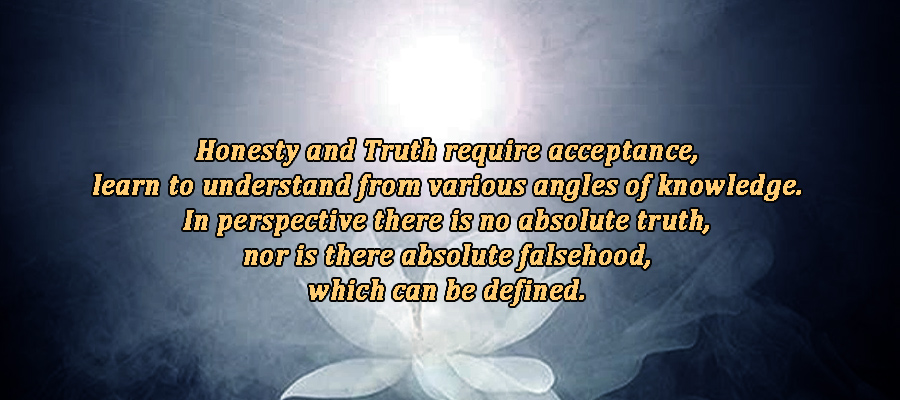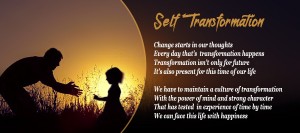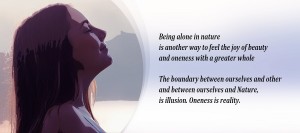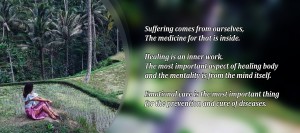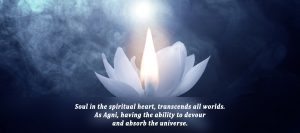A person should have a scientific temperament in exploring the truth and must also have a religious attitude in valuing the knowledge contained in the scriptures because religious knowledge cannot be verified and validated by science or by any other physical means. Truth is vast. Truth is infinite. You cannot measure it with one instrument or by one means. You need a comprehensive approach to unravel and understand our existence, the truths about our lives and about this world. We need to use both our minds and hearts to appreciate life. We need both science and religion to have a balanced approach to probe into the mysteries of the universe.
Hinduism appreciates the multi-pronged approach. Hindu philosophy about perspective has been largely ignored by the western world. Every perspective we call Darsana Hinduism or point of view. Darsana has a similar approach in Jainism. This is called Syadavada or founding theory. This means considering several points of view before arriving at the truth. From the moment we are born until we die we continue to push the limits of our knowledge and intelligence. And as we learn and grow, we also have to change our perspective. Changing new thoughts and insights is not a failure. It’s about learning, growing, and adapting. If we don’t turn around like that in real life, we will still live in caves and eat raw animal meat. We will never migrate to greener pastures and adapt to climate change on this planet.
Truth and Facts
People like to think there is absolute truth in any situation. It is a matter of holding the truth only as facts. People think that if you dig deep enough, there is a fact that really exists. Often the more the truth is digging, the more mud is found.
Humans like definition. The definition implies we can find answers for everything. The problem is the assumption that absolute truth exists in every definition. Taoism teaches that from a human perspective, there is no absolute truth, no total falsehood that can be defined or adhered to by someone. Taoism shows that human nature is itself a smaller part of a larger whole. When examining something, looking for an answer, finding a statement: every such examination will contain truth and falsehood.
- Even more confusing, the mixture of truth and falsehood is relative to each observer.
- Even more confusing, a mixture of truth and falsehood will shift for each person over time.
So when you see something, you accept the view that the world is a mixture of perceptions. In that perception, there will be elements of truth and falsehood.
What is Truth?
We all think we know the truth: something that cannot be changed and is defined outside of ourselves for the greater whole. Unfortunately, this is why people look for judges, priests, and outside experts to define/limit their truth.
Truth has two different aspects.
- External truths are truths that are determined by greater general standards.
- Inner truth is a truth that is defined by everyone relative to their own lives.
So, the question falls into two categories: Outer Truth and Inner Truth. Questions that fall into the Outer Truth Zone are questions that can be answered outside of one’s nature. For example: What is the right action? Right is an act according to …, defined in detail even to the point of being long …
Pretty clear right? Not. Because many questions eventually become relative:
For example, what is right doing? Depending on how you view the world, True can still mean something different. So for someone we call ‘Yogis’, their True may not be the same as the average in society.
So questions that depend on your nature are included in the category of Inner Truth.
So the question can have different answers depending on whether you are trying to answer relative to External Truths or Inner Truths such as “Is That Right?” When considering this: of course, one can get caught up in endless debate chasing questions. One knows the answer is unlimited. One can spend a lifetime chasing answers only to be chased after more. So one instead uses liberation as a way to overcome this unlimited pursuit. The release doesn’t need an “answer” to work, it’s not a release process. Chasing answers often will cause additional problems to emerge. Yes, sometimes, knowing the answers can help someone solve a problem. However, it’s often easier and faster just to let go and move on.
The problem is when someone tries to force questions that are of the Inner Truth as if it is a matter of Outer Truth.
This is the root cause of religion causing so many problems: trying to force personal answers as universal truths on others.
The problem is that much inner truth is determined by ego and personal needs. For example, some questions such as the acceptance of the mental attitude are rooted in the sphere of the ego. Ego-based questions cannot be answered from a universal perspective: apart from the ego’s insistence that they are universal. So in the end, the question “ego” must be answered by everyone. Giving general answers creates interpersonal conflicts. For some spiritual aspirants, this problem is easily avoided by leaving the question unanswered from a greater perspective. To recognize this question is a personal scope for each individual to balance in their lives.
Spiritual practice teaches a person how to simply embrace the ego lightly. In this way, the spiritual practice of solving many questions becomes unimportant. This is very important and has implications for many other questions.
What is Falsehood?
It seems that falsehood is something that is not true. This is a good starting point.
Let’s see in a moment. People often say light is the truth. That truth is projected out from a greater universal source. Fair enough, because, we are all one with the universe, part of our nature is projecting our own truth. This leads to a bit of conflict when people fight over the “projected” truth.
Delusion is when someone projects their reality: changing the truth outside to suit their needs. Every human being does this; it’s a matter of degree. In spiritual practice, we let go of the ego, in this release, eliminating the need to live in fantasy. The nature of the ego is projection. Falsehood/fantasy projections are rooted deeply in the nature of the ego as projections and use projections to control the larger world.
The interesting thing about falsehood is that it also has two sides. Falsehood reflects the nature of Truth. Outer Falsehood is a delusion projected out by humans. Inner Falsehood: something that is not right with your own perception of life.
At first, this definition of truth (in) as a mixture of facts, and stories will seem strange. You will ask how can a story be the basis of truth? However, truth is often coated with complexity, so the very definition of truth is also complex. We need to explore our nature to understand how humans hold and define truth (the mind).
How Truth Shapes Us?
We are like clay early in life and are shaped by the truth that impresses us. As we grow up, we hold the truth stories as a basis for resistance. Once we oppose a story, we harden it and keep it deep, even by sacrificing ourselves to stay in the truth when it’s wrong.
When we harden against our truths, we lose the flexibility to accept new truths.
Fortunately, every year our instincts are programmed to accept change: to let new stories enter our lives. At these points of life, it is possible to truly re-visit our inner truth to reshape ourselves. Some of these change points are bigger than others and have received names, such as a midlife crisis.
These points of greater change shift how people keep stories, and they often become a moment of crisis when someone struggles to redefine their truth. At this time of crisis, change often becomes a crisis of life because someone’s new truth is contrary to the norms of friends, family, and even society in their environment.
If you change your truth then don’t force your new truth too hard, it’s better to be patient to share a new truth when someone is ready to hear a new story. If the person you love changes, don’t try to hold it in. The lesson: never try to hammering our loved ones because it will only destroy them in the future. We must work gently with our relationship in change. Find time, the art of sharing stories of change, and gentle hands when it’s time to shape life against newer truths.
Honesty, Truth, and Stories
People think honesty means telling the truth. The basic problem is this: people often think that truth is fact. Too often the truth is a story and not a fact.
Everyone has stories that are composed and collected as collages to represent their lives.
The nature of inserting a collage-like a shared story can create a beautiful rug to be seen. We really appreciate storytellers. However, these tapestries often blind people who see them, trapping people to think that such a collection of words can represent absolute truth.
Because of the nature of the people who make up their life stories, no two people can perfectly match their stories. If the emphasis is placed on conflict between stories, then this regulates the dynamics of interpersonal conflict. So people look for some form of external truth to resolve such differences.
People look for honesty. The value of honesty because people define honesty to represent the truth. Just because many times we can use “facts” to defend “truth,” people assume honesty represents the ability to stick to facts. The deeper problem is often the truth is subjective; facts shift to perception and create a big problem for honesty. Because in too many cases, there are no honest answers that are “absolutely perfect” between conflicting stories.
Honesty, honesty cannot represent the truth. It represents the ability to connect your story in a way that matches the stories of others harmoniously.
When someone cannot spill their story to fit the “facts”, and most people hold the story as a fact outside the question, it creates a problem that is very difficult to overcome when resolving interpersonal conflicts from different stories.
Honesty is the ability to reconcile stories without judgment
This requires acceptance, learning to understand the story from various angles, bridging the gap of trust, to reconcile conflicts of such stories.
Humanity includes many stories to express life. Enjoy each story as it is, and discover how each story is about how someone relates to their world. If you do this, chances are you can teach others to open up and also find more than one story to keep in life. So one does not need to defend one story by putting everything else aside, but honestly, it becomes possible to bridge the gap between stories and find new stories to see the world.
Skeptics and Truth
Whoever seeks truth in its essence is a spiritual person, because the search for truth is their spiritual path.
Of course, this puts a lot of skeptics in an unsettled position. Because many skeptics are busy destroying various practices and beliefs to find the truth. So on the outside, it seems they are not spiritual in their practice.
Skeptics have a problem, because, oftentimes they try to find absolute external truths, even though, from a human perspective, truth is always inner truth. To have external truths means to let go inward … Something that skeptics don’t want to let go of because it means not accepting the final definition.
Two Sides of Truth
For science (western culture) one of the goals is to reduce falsification / inaccurate results to maximize knowledge. So, as a result, this forms the baseline for how many people are approaching problem-solving.
Because Truth and Falsehood are a paired concept: one creates a diminished return on benefits when exclusively pushing towards the truth. In fact, at some point, the drive for accuracy creates wrong readings and seeds of problems, which ultimately pushes someone to make a false statement.
When looking at any spiritual teachings, it has the same problem. People “focus” only on “their” truths or truths projected by certain teachings as “completely true”. Focusing only on the truth ultimately drives extreme ways of resolution, such as conflict, to resolve differences of opinion or even pursue the shadow of truth.
So, in the end, it’s easier for someone to accept everything that deals with a mixture of truth/falsehood in all the statements he encounters. Instead, learn how to “flip” which eventually becomes wrong. This allows one to learn as much as possible from the wrong aspects of what is encountered. One of the benefits of this approach is that it functions as a way to find harmony between conflicting points of view and how to balance many different personal truths.
These are all very important in working with potential because as a spiritual practitioner sort out how to relate to life and truth holistically.
Through Knowledge and Experience
For our personal growth and development, we need to adapt to this multi-learning approach. We need to use various perspectives or approaches to grow knowledge and stretch our minds in every direction that makes it possible to assimilate whatever knowledge we can gather in our life’s journey.
In this case, how can we gain truth of knowledge using a different perspective from the 5 Darsana that can be applied in life in this modern era. In Sanskrit terms: Dharma Darsana, Vijnana Darsana, Atma Darsana, Apara Darsana, and the Darsana.
1. Dharma Darsana means knowledge of religion, scriptures, religious duties, religious philosophies, spiritual practices, and properly established behaviors. Basically, this is a perspective that will be developed with the help of religious beliefs. This knowledge will help rise from everyday thinking, view life from a broader perspective, and work for freedom. Collectively, this knowledge must help us live responsibly and help one another in our struggle for survival.
2. Vijnana Darsana is the knowledge that arises from one’s objective, intelligent, and scientific study of the world and the universe in which we live. This knowledge will help us understand how Nature works and use that knowledge to face the challenges and modifications that Nature creates in us and the world in which we live.
In traditional Hinduism, we call it tattva jnana or knowledge of the reality of Nature. Science is basically a systematic study of Nature or the objective universe of matter.
Vijnana is empirical knowledge or worldly knowledge. It has limitations, but within those limits, it is very useful as an instrument of knowledge to understand the perceptual world and our relationship with it.
3. Atma Darsana means knowledge and awareness that arise from our own experiences and perceptions. This is the knowledge that is collected by ourselves through our own experiences and observations. Such experiences can be spiritual or purely physical.
This knowledge is very helpful in validating the knowledge we have obtained in other ways. It helps us to be realistic, examine our irrational beliefs, test assumptions and prejudices that we might enjoy, and grow maturity in our thoughts and actions. Most importantly, when we use our own experiences and observations, we will develop different personalities and very unique personalities. We will develop styles in thought, decision making, and action.
4. Apara Darsana means knowledge that we obtain from other people or other sources. Apara means something that is not-self. Other or other sources may include parents, relations, family members, friends, teachers, parents, other people, experts in certain fields, even television, news channels, radio, internet, and other communication tools. This knowledge may not be fully reliable, but we can still use it to expand our knowledge and understanding because knowledge cannot be guaranteed entirely by effort and from time to time it still depends on sources outside of ourselves.
5. The Darsana means transcendental knowledge that arises from deep spiritual conditions, from dreams, from intuition, and from spiritual experiences. This knowledge actually arises from a higher self-nature, not from an ordinary self-conscious nature. This experience which arises in a higher mental state is very rare, very difficult to validate and very difficult to imitate. This knowledge must be used exclusively for spiritual growth, not to show off, not to attract the attention of others or to prove to others our moral or spiritual superiority. It’s better to use that knowledge to improve yourself than to talk about it.
These five means of knowledge are like the five senses. They are like the five streams of knowledge that continue to flow into one’s mind and enrich the ocean within it. They can help solve problems and overcome challenges. So we have five ways to know: Darsana dharma, knowledge arising from religion, Vijnana Darsana, knowledge arising from empirical experience or interactions with the objective material world, Atma Darsana, knowledge arising from one’s own experiences and perceptions, Apara Darsana, the knowledge that arises from interactions with others such as teachers or from our parents, and Para Darsana, knowledge arising from our own transcendental state or the higher nature of the Self, or from intuition and other such means.

